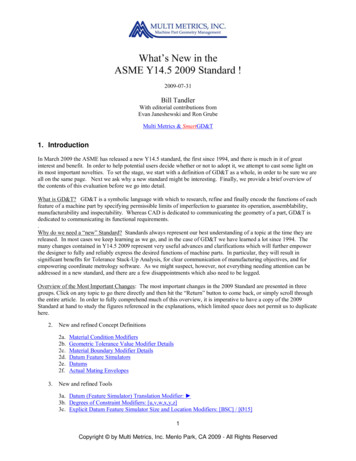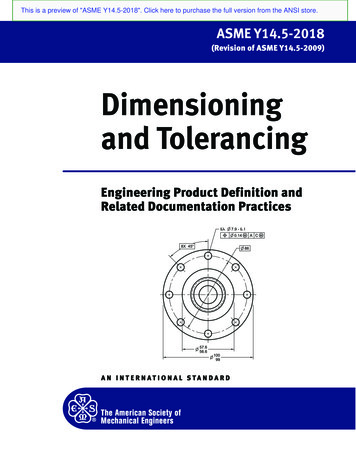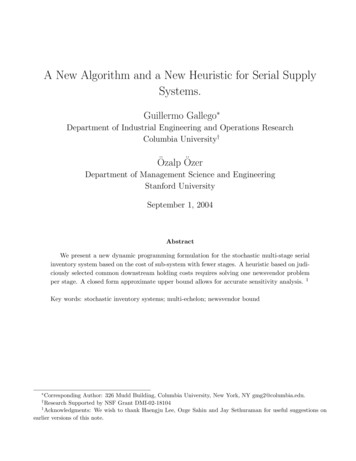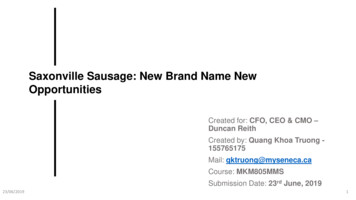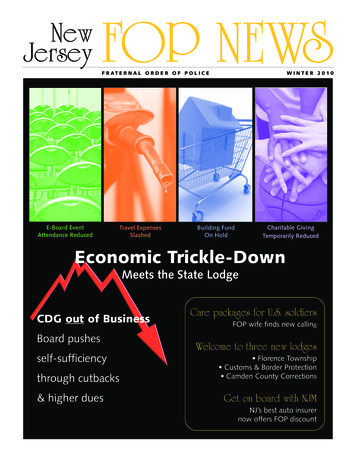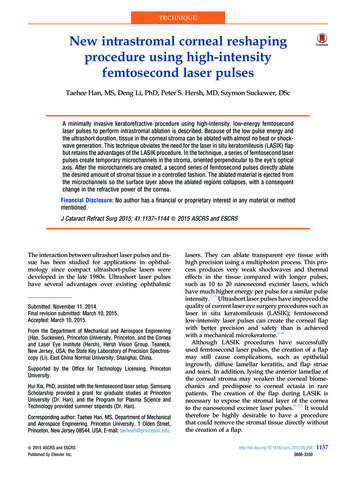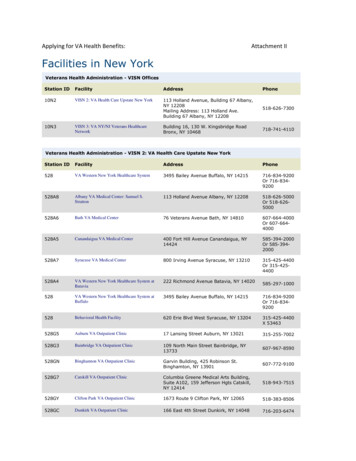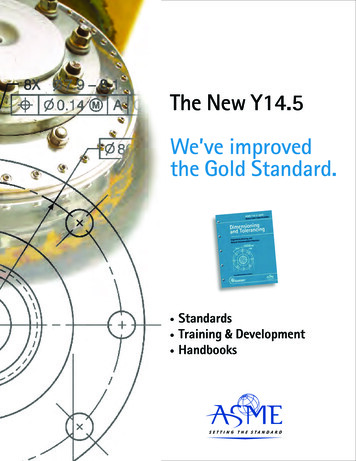
Transcription
The New Y14.5We’ve improvedthe Gold Standard.Standards Training & Development Handbooks
“ Ever since I became[GDTP] certified, we havechanged our designconcepts, reduced costs ondevelopment programs,and met quality and deliveryrequirements, whichincreases our competitiveedge. I have also advancedin my career with severalpromotions, with the latestpromotion as Manager ofManufacturing Engineering.”- B.P.MOOG Aircraft GroupThe New Y14.5The Gold Standardjust went Platinum.You all know our Y14.5 Standard as theauthoritative guideline for the design languageof GD&T. For top engineers worldwide, it’s anessential communications tool.But did you know that ASME is the mostrespected provider of GD&T training anddevelopment courses, plus handbooks, forengineering and design professionals?Build your design expertise,direct from the GD&T source !For details, call 1-800-THE-ASME(1-800-843-2763) or visit www.asme.org/kb/standards
About GD&T and Y14.5About this Revision: The Next GenerationThe Y14.5 standard is considered the authoritative guideline for the designlanguage of geometric dimensioning and tolerancing (GD&T). It establishesuniform practices for stating and interpreting GD&T and related requirementsfor use on engineering drawings and in related documents.Y14.5 was revised by a consensus panel of industry experts. Here is what onepanel member, a Technical Fellow at a leading aerospace manufacturer, has tosay about this “next generation”:GD&T is an essential tool for communicating design intent – that parts fromtechnical drawings have the desired form, fit, function and interchangeability.By providing uniformity in drawing specifications and interpretation, GD&Treduces guesswork throughout the manufacturing process – thus helping toimprove quality, reduce costs, and shorten delivery times.Now, a consensus panel of industry experts has revised Y14.5 for 21st-centuryapplications!In today’s economy, your company cannot afford mistakes in interpretingengineering designs throughout the manufacturing process. That’s why yourpurchase of the new Y14.5 is the best investment you can make today – foryour company and your career!Start with the new Y14.5. Then progress to ASME’s related offerings –Standards, Training Courses and Handbooks – to develop your GD&T fluency.ASME Y14.5 - 2009, Dimensioning and TolerancingRevised and improved ! establishes uniform practices for stating andinterpreting dimensioning, tolerancing, and related requirements for use onengineering drawings and in related documents.ASME Order No.: N00509 (Book); N0050Q (Single-User PDF)ISBN: 978-0-7918-3192-2Pages: 224“ The 2009 standard advances the state of the art without reversing past practices.Adopting the new standard enables clarity of requirements in complex applications that previously required notations. Adopting the 2009 standard also makesit possible to gain new capabilities without giving up anything of the past. Failureto adopt the 2009 standard would mean continuing to work with limitations thatcould be removed.The six most important changes the committee made in this revision are: Explanation of datum references in terms of degrees of freedom Allowing for customization of the degrees of freedom constrained bydatum feature references Expanding composite position tolerance explanations to includethree segments Simplification of the explanation of composite tolerances Clarification of surface boundaries taking precedence over axismethods of interpretation Expansion of the explanation of profile tolerancesPreviously, there were occasional disagreements regarding interpretation oftertiary datum feature references. The 2009 standard clarifies the defaultmeaning and allows for other desired effects to be achieved through new methods.The 2009 standard helps industry save money by making it possible to moreclearly define some requirements. That potentially will reduce the risk ofconfusion, errors in interpretation, and in some cases should minimize the riskof litigation.Finally, the material is now organized more logically with profile, orientation,and form in separate sections. The material within sections also was reorganizedto flow more logically.”
ASME’s Related GD&T Offerings:An Elite CompanyY14.5 has been rigorously studied and employed by a majority of NorthAmerica’s leading manufacturers and their suppliers, and by thousands ofother leading manufacturers throughout the world. GD&T practitionersrange broadly across industries and engineering disciplines.More than 100,000 copies of Y14.5 have been purchased since 1994. Buy yourcopy of the new Y14.5 now. Then progress to ASME’s related offerings –Standards, Training Courses, and Handbooks and – to help assure you don’tget left behind!” I believe that whoeveris dealing with designor related fields mustattend this course[GD&T Fundamentals].It is truly necessary anduseful.”- A.M.Barry ControlsAerospacePurchasers of ASME’s related GD&T offerings include such manufacturers as: General ElectricHalliburtonHoneywellIntelAllied SignalBAE SystemsGeneral DynamicsJohn DeereLockheed MartinBausch & LombPhilips BroadbandNetworks Freightliner Raytheon SystemsFord MotorBoston ScientificBechtelIBM MicroelectronicsWestinghouse ElectricGeneral DelphiEastman Kodak Harley-DavidsonLoral Space SystemsEcolabITT AutomotiveSiemensPratt & WhitneyWhirlpoolRolls-RoyceStryker InstrumentsBell HelicopterHewlett-PackardSchlumbergerand more. EducatorInspectorContract EngineerProject EngineerTechnical SpecialistJob titles include, but are not limited to: Design Engineer CAD/CAM/CAE Specialist Drafter, Production orManufacturing Engineer Process Engineer Quality EngineerTool or Gage EngineerEngineering ManagerCheckerEngineering Consultant
ASME’s Related GD&T OfferingsStandardsWith the related GD&T Standards that follow, ASME provides you withcomprehensive criteria for implementing GD&T effectively across yourmanufacturing supply chain.ASME Y14.36M - 1996, Surface Texture SymbolsASME Y14.41 - 2012, Digital Product Definition Data PracticesASME Y14.38 - 2007, Abbreviations and Acronyms for Use on Drawings and RelatedDocuments applicable to the preparation and revision of digital product definition data (data sets).ASME Order No.: N17112 (Book), N1711Q (Single-User PDF); ISBN: 9780791834077; Pages: 102ASME Y14.5.1M - 1994, Mathematical Definition of Dimensioning and TolerancingPrinciples for surface texture of solid materials (e.g. roughness, waviness, and lay) by providing a set ofsymbols for use on drawings, specifications, or other documents.ASME Order No.: N08096 (Book), N0809P (Single-User PDF); ISBN: 0791823199; Pages: 20 used on engineering drawings and related documentation.ASME Order No.: J00307 (Book), J0030Q (Single-User PDF); ISBN: 0791831221; Pages: 136ASME Y14.100 - 2004, Engineering Drawing Practices consistent with the principles and practices of ASME Y14.5M-1994. applicable to the preparation and revision of engineering drawings and associated lists.ASME Order No.: N13294 (Book), N1329P (Single-User PDF); ISBN: 0791822524; Pages: 82ASME Order No.: N13804 (Book), N1380T (Single-User PDF); ISBN: 0791829502; Pages: 44ASME Y14.2 - 2008, Line Conventions and LetteringASME Y14.43 - 2011, Dimensioning and Tolerancing Principles for Gages and Fixtures for use in the preparation of engineering drawings, including requirements for CAD(Computer Aided Design) and reduction and reproduction.ASME Order No.: N00208 (Book), N0020Q (Single-User PDF); ISBN: 9780791831687; Pages: 20ASME Y14.24 - 1999, Types and Applications of Engineering Drawings used to establish engineering requirements. It describes typical applications and minimumcontent requirements.ASME Order No.: N12299 (Book), N1229P (Single-User PDF); ISBN: 0791825981; Pages: 86ASME Y14.31 - 2008, Undimensioned Drawings graphically define items with true geometry view(s), predominantly without the use of dimensions.ASME Order No.: N18908 (Book), N1890Q (Single-User PDF); ISBN: 9780791831700; Pages: 40ASME Y14.34 - 2008, Associated Lists used for the verification of maximum material condition (MMC) size envelopes.ASME Order No.: N17011 (Book), N1701Q (Single-User PDF); ISBN: 9780791833483; Pages: 108ASME Y14.44 - 2008, Reference Designations for Electrical and Electronic Partsand Equipment for electrical and electronics parts and equipment.ASME Order No.: N18808 (Book), N1880Q (Single-User PDF); ISBN: 9780791831533; Pages: 28ASME B46.1- 2009, Surface Texture (Surface Roughness, Waviness and Lay) covers surface finish, roughness, texture, microfinish, nanotechnology, bearing area, calibration,certification, fractals, filters, step heights and instrumentation.ASME Order No.: M01909 (Book); ISBN: 9780791832622; Pages: 120ASME Order No.: N10208 (Book), N1020Q (Single-User PDF); ISBN: 9780791831632; Pages: 32ASME B89.4.10360.2 - 2008, Acceptance Test and Reverification Test for CoordinateMeasuring Machines (CMMs) Part 2: CMMs Used for Measuring Linear Dimensions(Technical Report)ASME Y14.35M - 1997, Revision of Engineering Drawings and Associated Documents describes methods to specify and test the measurement performance of Coordinate MeasuringMachines (CMMs). for the preparation and revision of parts lists, data lists, and index lists. for revising drawings and documentation; establishes methods for recording revisions.ASME Order No.: N13097 (Book), N1309P (Single-User PDF); ISBN: 0791824403; Pages: 24ASME Order No.: L08608 (Book), L0860Q (Single-User PDF); ISBN: 9780791831540; Pages: 78
The ASME Workforce TrainingAdvantage“ The course was evenbetter than I wasexpecting. The GD&Tmethods pointed outmany useful techniques.It was great to seeGD&T applied to realworld problems.”- F.M.Water Corp. ASME provides technical expertise, direct from the industry leaders whocollaborate to develop our renowned Codes and Standards. Gain hands-oninsights, so vital when applying theoretical understanding to your realworld situations. ASME courses are subject to rigorous peer review to assure accuracy,comprehensiveness and relevance to the Standards. We offer these coursesin multiple formats to accommodate your budgets, schedules and businessrequirements. Moreover, ASME will customize our courses for yourspecific needs. ASME has been setting the standard for 125 years, promoting industrybest-practices and technology transfer, while preserving public safety.Discover how “the ASME Advantage” can benefit your organization.
Training CoursesAs a recognized leader in training for engineers and technical professionals,ASME offers courses that boost technical proficiency and develop overall business/management skills. ASME instructors are experts in their fields with most servingactive roles on ASME Codes and Standards development committees.Drawing Interpretation Online CourseOur specialized courses are designed towards the needs of industry professionals andcombine academic rigor with applications to real-world situations.(Short Course) Participants of this course will study and apply techniques on the proper design,dimensioning and tolerancing of GO gages, NOGO gages, Functional Gages and Fixtures per the newlyissued ASME Y14.43-2003 standard.Moreover, these courses can be tailored to the location and content needs ofyour organization.ASME Course No.: PD515; CEU’s: 2.30; No. Days 3.“Excellent use of real-life examples. Instructor clearly knowledgeable onsubject matter.” – C.G., W. L. Gore & AssociatesFor onsite training and customized courses, contact Paul Francis, ASME Manager ofCorporate Development, 973-244-2304, francisp@asme.org.For specific course offerings and dates, contact ASME.(Online Instructor-led Course) understand basic mechanical two-dimensional engineering drawings.ASME Course No.: ZI208; CEU’s: 2.30; No. Days: 43Dimensioning and Tolerancing Principles for Gages and Fixtures (GD&T) Y14.43Geometric Tolerancing Advanced Applications with Stacks and Analysis (GD&T)(Short Course) Using computer animated color graphics and demonstrations with wood and plasticmodels, participant teams will learn to apply and verify geometric tolerancing. The participants will applygeometric tolerancing to a series of case study problems to meet functional requirements.ASME Course No.: PD561; CEU’s: 1.50; No. Days: 2Mechanical Tolerancing for Six Sigma(Short Course) The course teaches participants how to solve assembly stacks using both traditional andSix Sigma methods. We highlight the design risks that are associated with the classical methods of toleranceanalysis, and introduce Six Sigma methods that will eliminate these risks.ASME Course No.: PD449; CEU’s: 1.50; No. Days: 2Geometric Dimensioning & Tolerancing Fundamentals 1(Short Course) an in-depth study designed to develop a basic working knowledge in GD&T.ASME Course No.: PD570; CEU’s: 1.50; PDH’s: 15.00; No. Days: 2Basic Geometric Dimensioning & Tolerancing (GD&T) Y14.5M(Online Instructor-led Course) covers most of the geometric dimensioning controls used onmechanical engineering drawings. Also covers areas of design, tooling, production, and inspection.ASME Course No.: ZI010; CEU’s: 2.30; No. Days: 43Advanced Geometric Dimensioning & Tolerancing (GD&T) Y14.5M(Online Instructor-led Course) develop Advanced GD&T competencies.ASME Course No.: ZI100; CEU’s: 2.30; No. Days: 43
How to OrderHandbooksYou have four convenient ways to order the new Y14.5.ASME conducts one of the largest technical-publishing operations in theworld. Its ASME Press publishes high-quality professional and referencebooks, handbooks, non-ASME conference proceedings, as well as advancedmonographs in selected subject areas of interest to mechanical engineersand allied disciplines. This handbook – available as a Print-Book orDigital Download (PDF) – is an example of the high quality and real-worldpracticality that characterize our offerings.
er No.: J00307 (Book), J0030Q (Single-User PDF); ISBN: 0791831221; Pages: 136 . ASME Y14.100 - 2004, Engineering Drawing Practices applicable to the preparation and revision of engineering drawings and associated lists. ASME Ord. er No.: N13804 (Book), N1380T (Single-User PDF); ISBN: 0791829502; Pages: 44. ASME Y14.43 - 2011, Dimensioning and Tolerancing Principles for Gages
